Butterflies are widely appreciated for their beauty and their fleetness on the wing, as much as they are associated with transformation, hope, joy and love.
In this post I celebrate some of the butterflies that visit our garden – choosing from those that settled long enough to be photographed.
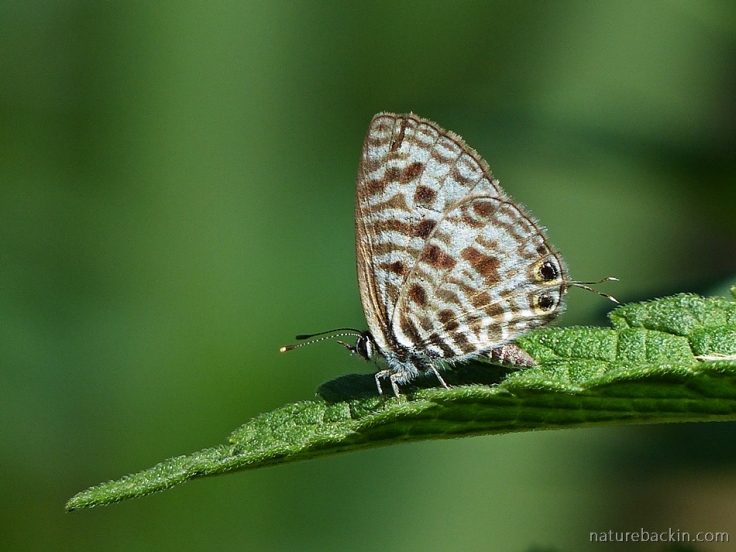
Common Zebra Blue – Leptotes pirithous
One of the smallest butterflies I have photographed in the garden is the Common Zebra Blue. When they settle it is usually with their wings folded, concealing the blue colouring of the upper side of the wings. The average wingspan is only 21 to 30 mm.
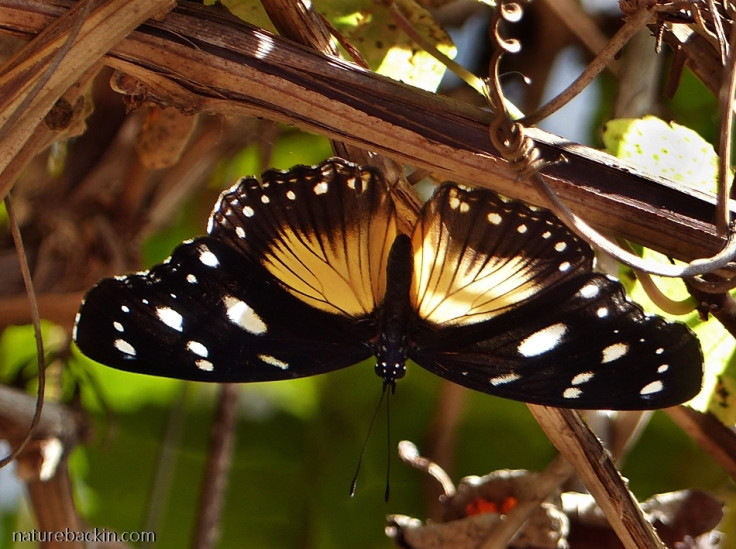
Variable Diadem – Hypolimnas anthedon wahlbergi f. mina
This much larger butterfly with an average wingspan of 75-90 mm seems to be a winter visitor. It is associated with forest or well wooded savanna. It was interesting to identify this butterfly although I am not entirely certain I am correct in thinking it is a Variable Diadem. This species of butterfly not only mimics the colouring of another species, but there are two forms of the Variable Diadem, with one form mimicking the Layman and the other mimicking the Friar, species of butterfly that are both distasteful to predators. I think that the one in the photograph is the form that mimics the Layman, and its full name is Hypolimnas anthedon wahlbergi f. mina, whereas the other form that mimics the Friar is Hypolimnas anthedon wahlbergi f. wahlbergi. The caterpillars (larvae) of the Variable Diadem feed on nettles, especially the river nettle (Laportea peduncularis).
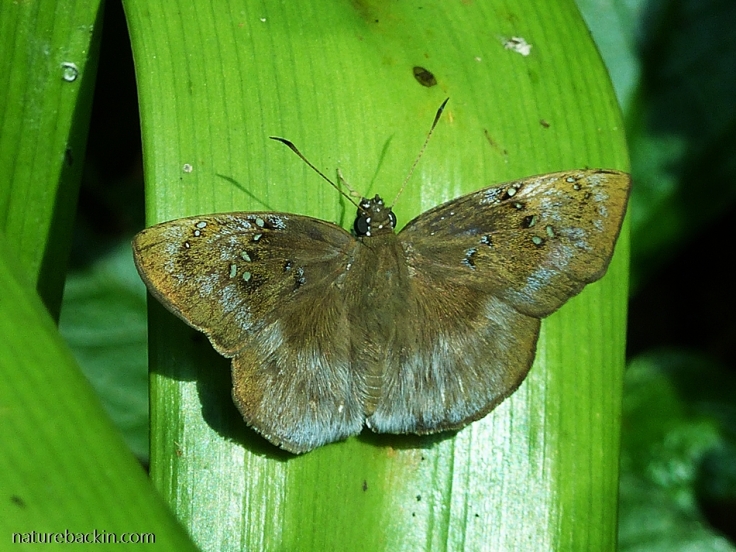
Clouded Forester – Tagiades flesus
The Clouded Forester (wingspan 35-49 mm) occurs primarily in forest and woodland and prefers damp and shady environments. I saw this one sunning itself on a plant at our garden pond and did not see it fly. I must look out for these butterflies as the hindwings have snowy-white undersides that are conspicuous in flight. The larval host plants for the Clouded Forester species are tuberous woody climbers in the Dioscorea genus.

African Leopard – Phalanta phalantha aethiopica
Also seen sunning itself at the pond, on the leaves of an Arum Lily, was a mighty flighty African Leopard butterfly (wingspan 40-48 mm), which would not let me approach. This butterfly is associated with savanna and woodland and its larval host plants belong to the Willow family. The African Leopard’s nocturnal caterpillars will feed on a variety of plants in this family including native and exotic Salix (willows), exotic poplars, and also species of plants in the Dovyalis and Oncoba families, such as the Kei Apple (Dovyalis caffra), which we grow in our garden.
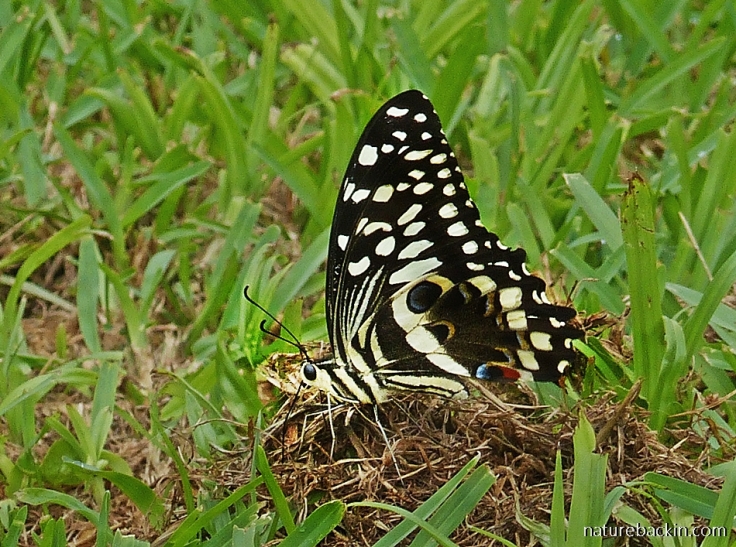
Citrus Swallowtail – Papilio demodocus
One of the showiest and flightiest of all butterflies flitting through our garden is the large Citrus Swallowtail with a wingspan of 90 to 110 mm. It occurs in many different habitats and larval host plants include Apiaciae species (celery, parsley or carrot family) and Rutaceae species (Rue family), which include citrus species as reflected in its name. This butterfly was flitting over the lawn and landing to sip morning dew that had collected in small pockets of lawn clippings. It too would not tolerate me approaching and I had to zoom in to photograph it.
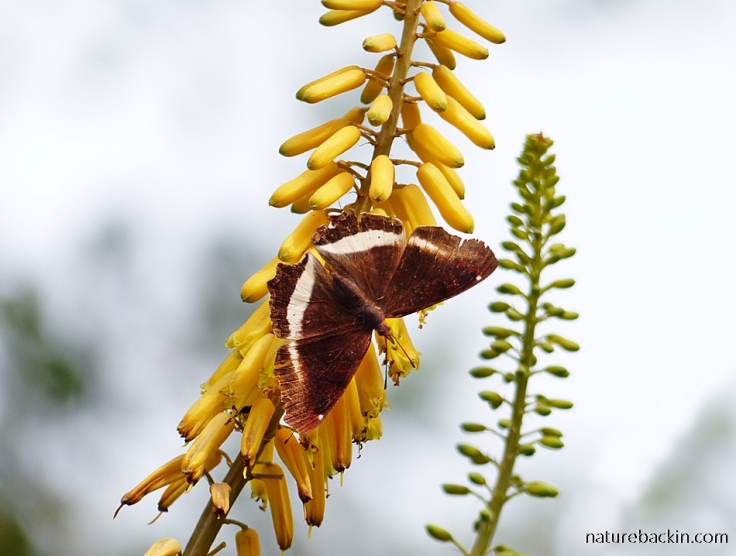
Pied Piper – Eurytela hiarbas
I managed to photograph this Pied Piper (wingspan 45-55 mm) nectaring on Fence Aloe flowers against the background of a cloudy sky. It tolerated me sitting on the ground but not if I stood up. They are often found in disturbed area of forest and the larvae feed on stinging nettles (Tragia glabrata) and also the Castor Oil plant (Ricinus communis).
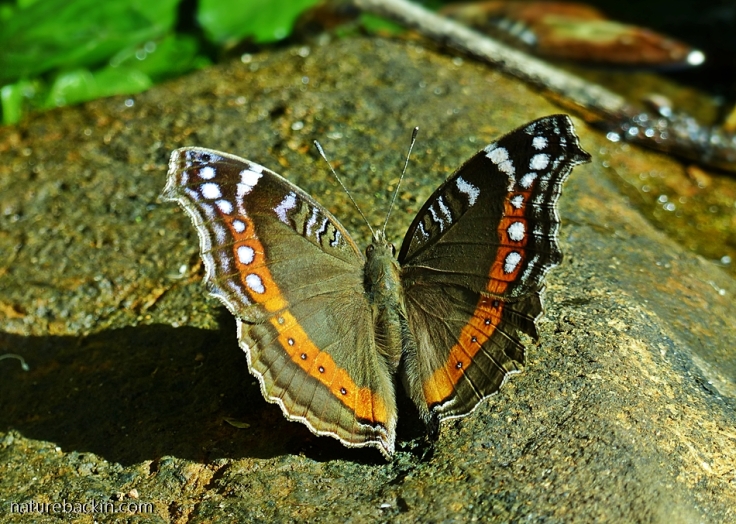
Garden Commodore – Precis archesia
I have posted about the Garden Commodore (also known as the Garden Inspector) before, see here. This grassland and savanna species of butterfly is medium-sized with a wingspan of 45-60 mm. These butterflies hang around close to (and sometimes inside) the house during the winter months. They can be very tame and sometimes even land on us when we are sitting outside in the winter sunshine. This individual was photographed at the garden pond. It and the one in the header photo are showing the colours of the winter or dry-season form. We see Garden Commodores in the garden each winter, whereas the Gaudy Commodore is a far less frequent visitor. Larval host plants of both butterflies include several species of Plectranthus.

Dead-leaf (Eared) Commodore – Precis tugela tugela
Only last week did I get the opportunity to notice this species of butterfly, seeing this one that had settled quite high off the ground in a Pigeonwood tree. It let me walk around underneath where I could appreciate the “ears” tufting its wings and admire the white underside to its body and its folded “brush” forelegs. The photo shows why this Commodore is sometimes known as the Eared Commodore, but it does not show why it is better known as the Dead-leaf Commodore. When the butterfly rests with wings folded the colour and shape of underside of the wings closely resemble a dead leaf, providing most useful camouflage for this forest and woodland species.
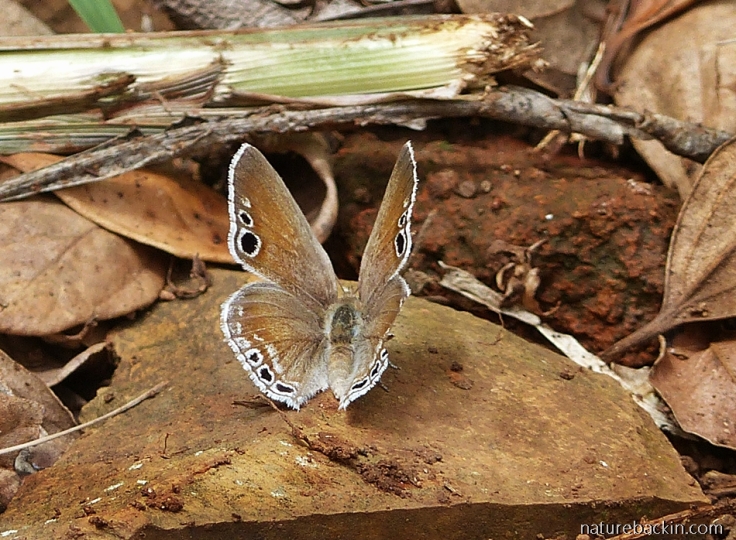
Common Black-eye – Leptomyrina gorgias gorgias
I rather like the relatively sober colouring of what I take to be a Common Black-eye butterfly (wingspan 18-32 mm) photographed trying to absorb some warmth from a rock on an overcast day. In my pocket guide to butterflies it says that the male of this savanna and grassland species is “territorial, perching on low rocks and shrubs chasing intruders away”. Well I didn’t see any intruders for it to chase, but it is gratifying to see it perching on a low rock as described in the guide. Its caterpillars feed on succulent plants in the Crassulaceae family.

African Common White – Belenois creona severina
Most noticeable during autumn is the African Common White butterfly that somehow manages to look larger than its 40-45 mm wingspan would indicate. It often perches with its wings open and so the more colourful underside of the wing is more often seen when it is in flight or nectaring from flowering plants.

African Common White butterfly showing the underside of the wings
I took this photo while a pair of African Common White butterflies spent a busy morning taking nectar from the flowers of a Ribbon Bush (Hypoestes aristata), an autumn-flowering shrub that is popular with a variety of insects. The African Common White is a bushveld and woodland species of butterfly and its larval host plants are species of Boscia, Capparis and Maerua.

A skipper butterfly in the Hesperiidae family also drawing nectar from flowers of the Ribbon Bush (Hypoestes aristata)
The Hesperiidae family is large with dozens of species occurring in South Africa. At a flying guess I think that this butterfly might be from the subfamily, Hesperiinae, of grass skippers or banded skippers. Common names for species within this subfamily include skipper, hopper, swift and (rather mystifyingly) hottentot. As an even wilder guess I wonder if the butterfly I photographed is perhaps a Dark-banded Swift? The Hesperiidae family illustrates well the often blurred distinction between what we call butterflies and moths.
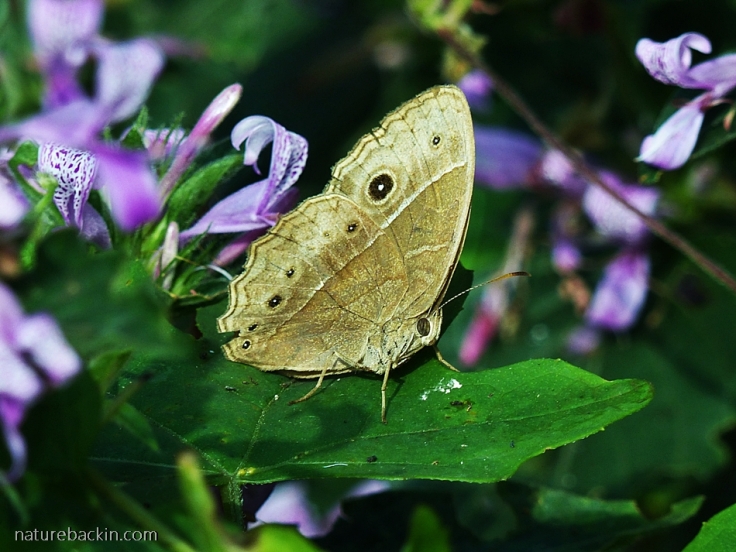
Eyed Bush Brown – Heteropsis perspicua perspicua
Sticking with the theme of butterflies enjoying the Ribbon Bush is a photograph of one of the browns or bush browns. Also a bit of guess, I think this is an Eyed Bush Brown (wingspan 38-48 mm). It is associated with wetlands, riversides and dams, so I wonder if our pond and a stream in the vicinity would be enough to attract it? We do, however, have its larval food plant in the garden – the Guinea Grass (Panicum maximum). It is worth noting that many butterfly (and moth) species utilise species of grasses as food plants, as I recently discovered, so local wild grasses should not be overlooked when providing plants for a diversity of species in the garden.
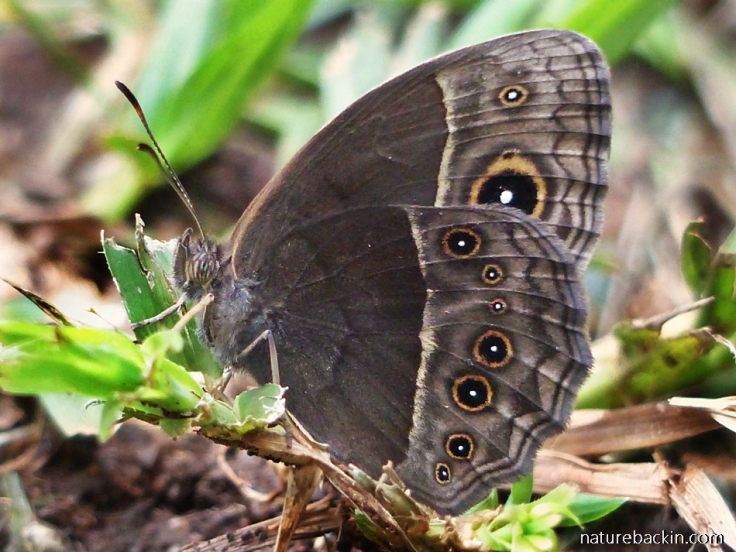
Common Bush Brown – Bicyclus safitza safitza
Rather easier to identify (I think) is the Common Bush Brown (wingspan 40-48 mm), a creature of the forest and well wooded savanna areas. I often see individuals perched low down especially on grasses. Their caterpillars are nocturnal and they feed on forest shade grasses, including on basket grasses such as Oplismenus hirtellus, which we use in our garden as an effective ground cover in shady areas. These grasses are popular with several species of birds too, especially when seeding.

Blood-red Acraea – Acraea petraea
The Blood-red Acraea and its larval host plant, the African Dog-rose (Xylotheca kraussiana) featured in a previous post, see here. In these two photos, a male Blood-red Acraea is using its proboscis to suck up droplets of rain that have collected on moss and dry leaves in an area paved with bricks.
Blood-red Acraea sucking up droplets of moisture
In case you missed my earlier posts on the beautiful Battling Glider butterflies after hatching see here and also the next post that features video footage of Battling Glider butterflies emerging from the pupa.
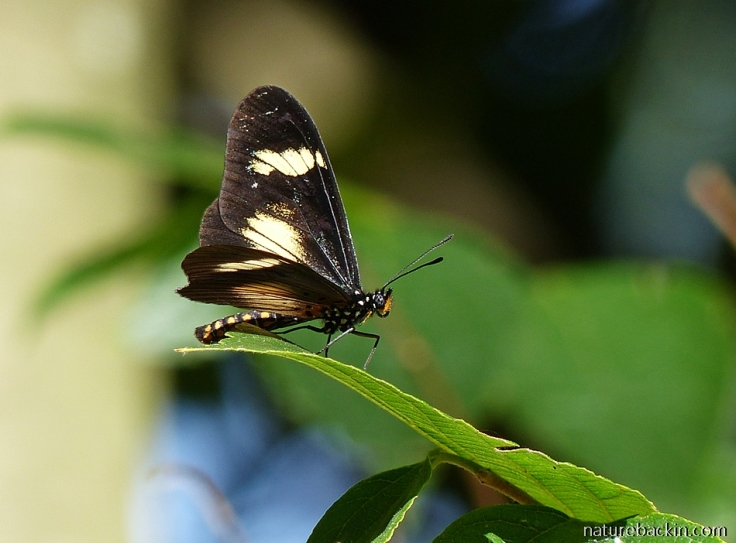
Acraea, Dusky – Telchinia esebria
Another butterfly species commonly seen around the garden in the autumn is another species of Acraea, the Dusky Acraea, a forest species with a wingspan of 45-60 mm. It is an attractive butterfly that seems to favour perching quite high up from the ground. Its larval host plants are species of nettle (Urticaceae).
Like most people, I enjoy seeing butterflies around. They do seem to encapsulate a sense of freedom, and I like that they are commonly associated with hopeful notions relating to transformation and rebirth, love and joy.

A tremendous variety of flowering plants are attractive to butterflies, though not all butterflies eat nectar. Some eat from fallen fruits and some butterflies do not eat at all. When planting for butterflies, it is necessary also to plant for caterpillars, which of course are butterflies in their larval form.
Butterflies will not stay to breed in areas without larval host plants. Some caterpillars can feed off a number of species of plants and others are very specific with some species feeding off only one species of plant. For this reason it is crucial to plant native plants especially regional natives, in order to sustain diverse species of butterfly.
Whether you have a balcony or a large garden there is plenty of scope to find suitable plants that provide for butterflies. There are many sources of information out there to help find native plants that will sustain butterflies and many other creatures besides. In the face of all that is daunting, why not go boldly forth and plant some butterfly food plants today!
Sources:
Bird Forum. South African Butterfly. https://www.birdforum.net/showthread.php?t=61028; Hoskins, Adrian. Butterflies of Africa. Learn About Butterflies http://www.learnaboutbutterflies.com/Africa%20thumbs.htm; Willis, Christopher & Woodhall, Steve. 2010. SANBI Biodiversity Series 16. Pretoria: South African Biodiversity Institute (SANBI). https://www.sanbi.org/sites/default/files/documents/documents/bioseries16butterfly.pdf; Woodhall, Steve. 2013. Butterflies of South Africa. Pocket Guide. Cape Town: Struik Nature.
Posted by Carol










September 13, 2019 at 4:00 pm
A lovely set and very informative. I have recorded 17 species in my garden here in the UK not bad out of total of 58 for the whole country.
LikeLiked by 1 person
September 14, 2019 at 8:22 pm
Thanks Brian. I am not an expert on butterflies at all, but learning a little more about them as I go. That is interesting to know there are 58 species of butterfly in the relatively small islands of the UK, and great to have so many visiting your garden. Your butterfly photos are superb.
South Africa is not only much larger but also has a wide diversity of biomes and I was stunned to learn that it hosts nearly 700 species of butterfly.
LikeLiked by 1 person
September 14, 2019 at 8:40 pm
700! My wife would have kittens if I was let loose in your country!
LikeLiked by 2 people
September 14, 2019 at 8:51 pm
🙂
LikeLiked by 1 person
September 8, 2019 at 10:29 am
Lovely collection of species! The UK has a fair variety of butterflies but our climate and the fact we’re an island means that we have fewer than continental Europe, let alone the warmer parts of the world. It sounds like this kind of ‘leopard’ isn’t much easier to photograph than the feline type!
LikeLiked by 1 person
September 11, 2019 at 6:30 pm
It stands to reason that an island would have fewer species than on the continent, now that I think about it.
Yes indeed leopards of both kinds can be shy and elusive!
LikeLiked by 1 person
August 29, 2019 at 5:13 pm
Remarkable. Your garden must be a butterfly’s paradise
LikeLiked by 1 person
August 30, 2019 at 1:09 pm
At least some do their whole life cycle here. In autumn when they are most noticeable perhaps some are just passing through.
LikeLiked by 1 person
August 27, 2019 at 7:21 pm
Oh my wow! I’m so jealous. I’ve always wanted to have a garden designed specifically to attract butterflies. Beautiful photos, look forward to seeing more.
LikeLiked by 1 person
August 29, 2019 at 10:09 am
Thank you Miranda. Btw, we try to make our garden wildlife-friendly in general and not only for butterflies. The nice thing is that what is good for one species is often good for many others too 🙂
LikeLike
August 26, 2019 at 11:49 pm
Beautiful collection and superb narrative. The variety of butterflies and habitats are really impressive – I’m jealous! Clearly, you understand the wildlife survival triangle and have the landscaping talent to make a serious contribution to the enhancement of Lepidoptera populations. Thanks for sharing the fruits of your labors!
LikeLiked by 1 person
August 29, 2019 at 8:59 am
Thank you for your kind comment and encouragement Nick. We are fortunate that we bought our place from previous owners who had done a lot of planting of native plants and trees. Although we have added some plants, it is really that we – as well as many creatures and birds – are benefiting from what they did before us. My hope is that more and more people with gardens create wildlife-friendly patches, as a mosaic of even small areas like this can contribute to the survival of many forms of life, including butterflies.
LikeLike
August 26, 2019 at 3:12 am
I know that struggle hoping some butterfly would settle long enough to be photographed all too well. Then again, this year we seem to have far fewer than normal butterflies here. Perhaps it’s because we’ve cut back on the extremely invasive Himalaya Blackberries. The butterflies (and bees and birds) really seemed to enjoy the blossoms. We’ve tried introducing native plants, but it’s taking awhile for them to get established. Some have been struggling a bit because it’s been a very dry summer. Perhaps we’ll do better next year.
Thank you for sharing your lovely collection of beauties to tide me over.
LikeLiked by 1 person
August 26, 2019 at 12:08 pm
Thanks Gunta. Yes butterflies are not the most cooperative 🙂 Nice when they do though.
I hope you get more butterflies next season and that the native species you have planted get established.
I think there is an interesting balance between planting native plants while at the same time there can be a need to retain cover (and food) for wildlife that might require the retention of some alien plants at least in the interim. It is an issue that I think about quite a lot. I know in our area many animals hide and shelter in alien plants (including thickets as well as tall trees) without which they would probably die. A case in point are the Crowned Eagles that require tall trees to nest in and in some areas the only suitably tall trees around are alien species (there is an interesting summary of a research project on these large threatened eagles here: https://researchspace.ukzn.ac.za/handle/10413/14072).
There has been a drive to fell these alien trees (mostly eucalyptus) but that would have an adverse effect on these and other raptors. I guess a nuanced and locally contextualized response may be appropriate in these changing times.
LikeLike
August 25, 2019 at 6:55 am
What a lovely selection of butterflies. The photos are terrific and the information very interesting. I haven’t been seeing many here lately so I am indeed envious
LikeLiked by 1 person
August 26, 2019 at 11:50 am
Thanks Graham. The variations in the seasons and across the years have many knock-on effects including on butterflies it would seem. Inspired by my post, we have just made a butterfly puddling spot and await its first visitors 🙂
LikeLiked by 1 person
August 25, 2019 at 2:26 am
Fantastic post, Carol. Interesting facts about butterflies and wonderful images. Such beautiful creatures. I was just driving through the Tahoe are a couple weeks ago and came across a huge swarm (flock?) of butterflies– they were everywhere. Apparently a bumper year due to the super bloom in CA. I think the species was the one in your lead photo. 🙂
LikeLiked by 1 person
August 26, 2019 at 11:48 am
Thanks so much Jane. How lovely for you to see so many butterflies this season. I also am not sure of the collective term for butterflies 🙂
LikeLiked by 1 person
August 23, 2019 at 8:10 pm
A breath-taking collection Carol, beautiful insects beautifully portrayed.
LikeLiked by 1 person
August 24, 2019 at 2:22 pm
Thank you very much Theresa. I am sorry I was not able to photograph those that seldom seem to settle!
LikeLike
August 23, 2019 at 5:36 pm
Fabulous shots of these magnificent insects Carol!
LikeLiked by 1 person
August 24, 2019 at 2:21 pm
Thanks very much Pete 🙂
LikeLike
August 23, 2019 at 4:53 pm
Lovely shots, Carol.
About three or four of your collection visit our spot.
LikeLiked by 1 person
August 24, 2019 at 2:20 pm
Thanks Ark. Nice to know that you also enjoy such beautiful visitors 🙂
LikeLike
August 23, 2019 at 1:29 pm
Such gorgeous specimens! We have plenty of lovely butterflies too of course but it’s a pleasure to enjoy this collection. Common sights in your garden but exotic for us in the UK.
LikeLiked by 1 person
August 24, 2019 at 2:20 pm
Thanks Sandra, butterflies everywhere are truly gorgeous 🙂
LikeLiked by 1 person
August 23, 2019 at 8:44 am
Such beautiful butterflies you have in South Africa. Quite, great contribution!!
LikeLiked by 1 person
August 23, 2019 at 6:15 pm
I mean quite a great post! 😊
LikeLiked by 1 person
August 24, 2019 at 2:21 pm
Got it! Thanks 🙂
LikeLiked by 1 person
August 24, 2019 at 2:19 pm
Thanks Simone, yes there is an incredible variety of butterflies here.
LikeLiked by 1 person
August 23, 2019 at 6:45 am
Beauty at its best and such a wonderful post so informative.
LikeLiked by 1 person
August 24, 2019 at 2:18 pm
Thank you very much Kamal. Butterflies do have a unique beauty.
LikeLike
August 24, 2019 at 2:38 pm
Welcome 😊😊 😊 yes absolutely
LikeLiked by 1 person
August 23, 2019 at 5:15 am
I battle to photograph butterflies so doff my hat to you. You have a very pleasing variety of butterflies visiting your garden. Off the topic, but you mention growing a Kei Apple in your garden. I have one too and at the moment it is heavy with fruit, yet none of it – either on the tree or the ground – is eaten by birds. Do you have a similar experience?
LikeLiked by 1 person
August 24, 2019 at 2:17 pm
Thanks Anne. Fortunately there are a few butterflies that occasionally perch for periods of time long enough for the camera 🙂
Re the Kei Apple, the Vervets eat the fruits here and they seem to prefer them to be really ripe, even waiting till the fruits start dropping to the ground. There might be the occasional visit from a Dark-capped Bulbul, but the birds do not seem to be that attracted to the fruit,, which is indeed odd.
Mind you, I tasted the fruit and they are extremely sour even when they are very ripe!
LikeLiked by 1 person
August 23, 2019 at 4:32 am
What an incredible variety of butterflies you can boast, Carol! Testament again to the wildlife paradise your garden has become through your loving dedication!
LikeLiked by 1 person
August 24, 2019 at 2:11 pm
Thanks so much. We are fortunate too, to be living on the edge of town.
LikeLiked by 1 person
August 23, 2019 at 3:18 am
Carol you have created a visual feast from the wealth in your garden, as always I also appreciate the wonderful information in your post! xxx
LikeLiked by 1 person
August 24, 2019 at 1:27 pm
Thanks Christeen. We do seem to be fortunate to have so many species of butterfly about in our region. This spring we hope to add a few more butterfly-friendly plants to the mix in our garden 🙂
LikeLiked by 1 person
August 23, 2019 at 12:45 am
A beautiful post, Carol. You have so many gorgeous butterflies! I’m glad you ended with the suggestion to plant more native host plants. They need all the help we can give.
LikeLiked by 1 person
August 24, 2019 at 1:26 pm
Thank you Eliza, and its true they do need our help with us planting more larval host plants. I am finding it so interesting as I gradually learn more about them and the relationships between species and the process of discovering such a variety of overlooked plants too.
LikeLiked by 1 person
August 22, 2019 at 11:26 pm
You capture amazing photos!
LikeLiked by 1 person
August 24, 2019 at 1:23 pm
Thanks so much Buddy. Of course one has to bear in mind the very, very many that I missed 🙂
LikeLike
August 22, 2019 at 9:46 pm
Here in the UK we’re having a good year for butterflies. But we don’t enjoy anything like the variety that you illustrate. Great portraits – and great names too. And thanks for all that info.
LikeLiked by 1 person
August 24, 2019 at 1:22 pm
Great that you are having a good butterfly year. Thanks, and yes some of the butterfly names are interesting and some quite quaint 🙂
LikeLiked by 1 person
August 22, 2019 at 8:00 pm
Gorgeous gallery! I am happy to say that we have more butterflies this year than I can ever remember. Of course they are not as spectacular as yours up here, but still – lovely. If I look out my window I can see at least 20-30 butterflies on my bushes and plants – every time. So grateful.
LikeLiked by 1 person
August 24, 2019 at 1:20 pm
Thank you Leya. How wonderful to be enjoying so many butterflies in your part of the world this season 🙂
LikeLike
August 24, 2019 at 10:56 pm
It is!
LikeLiked by 1 person